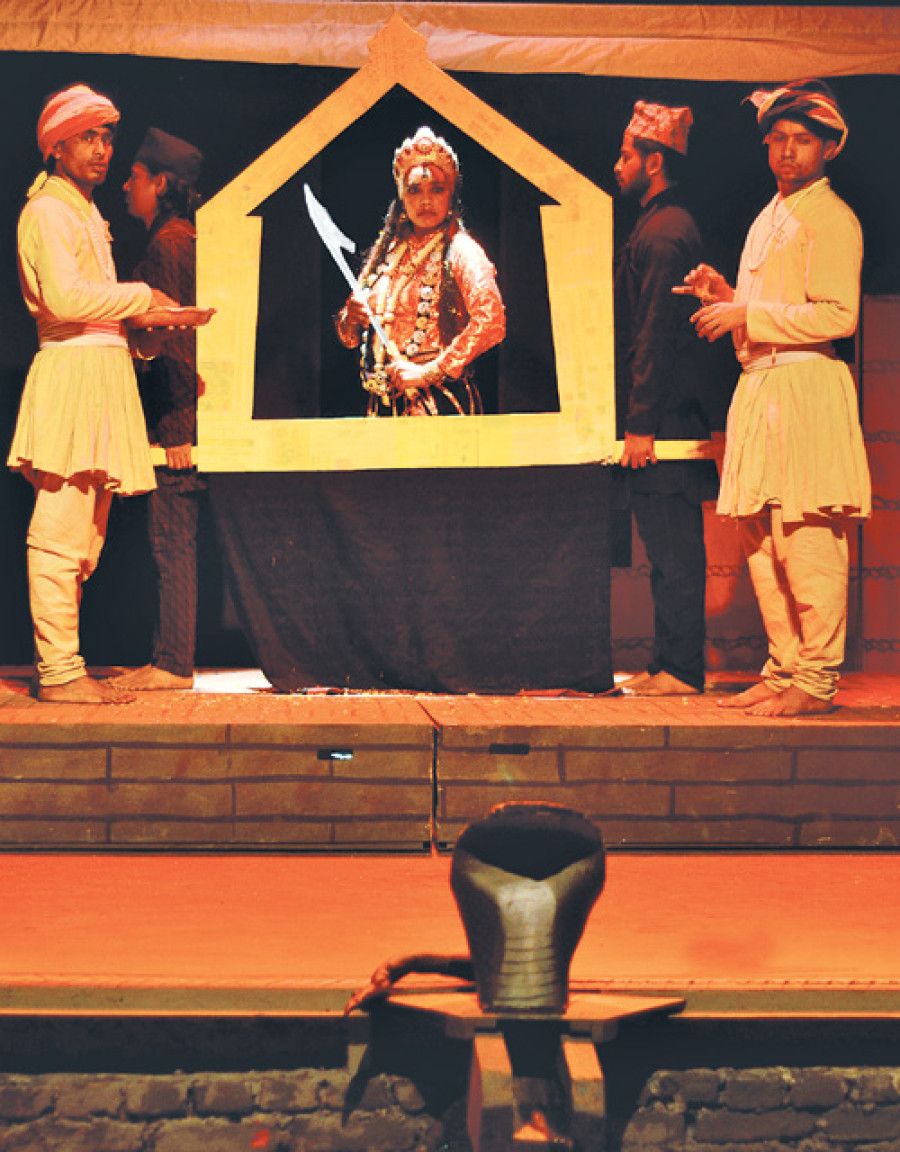Miscellaneous
A celestial theatre
There seem to be two schools of plays currently being staged in Kathmandu. One that is pushing the boundaries of the traditional mores that dictate the Nepali theatre-scape—bringing new motifs and consciousness to stage, giving voice to the traditionally voiceless; the other tugging at Nepal’s rich religious and mythological history and making them relevant to the present day and age.
Timothy Aryal
There seem to be two schools of plays currently being staged in Kathmandu. One that is pushing the boundaries of the traditional mores that dictate the Nepali theatre-scape—bringing new motifs and consciousness to stage, giving voice to the traditionally voiceless; the other tugging at Nepal’s rich religious and mythological history and making them relevant to the present day and age. The play Chiriyeka Saanjh Haru—written by Abhi Subedi and directed by Ghimire Yubraj, that concluded staging earlier this week—is of the latter variety. Following the recent lineage of plays at Shilpee, like the reimagining of Bhisam Sahni’s Madhavi, Chiriyeka Saanjh Haru blended mythical tales with the real, making incisive social commentary along the way.
Chiriyeka Saanjh Haru was first staged in 2006 at an international theatre fest in Kathmandu. Now, adapted for modern tastes by Ghimire Yubaraj, the play was brought to stage by the fifth batch of Shilpee’s theatre students and unpacked the central myth behind the venerated Bisket Jatra of Bhaktapur.
From the very opening sequences of the play, it was clear that the producers intended to transport the audiences to ancient Bhaktapur, with a thick waft of incense smoke and a gurgling hiti welcoming you into the theatre. As the lights come on, the Lord Bhairav and his paramour Mahakali, are having a disagreement about humans—which was brought to life expertly through a well-choreographed sequence. Lord Bhairav is perturbed that the human spirit has become so fiercely independent, even audacious, that it refuses to bow down to even the gods. He, therefore, declares that he shall no longer grace the yearly Jatra in Bhaktapur in person, much to Mahakali’s bemusement. As the scene closes to the crashing of incessant cymbals, Mahakali vows to see to it that her lover does continue attending the jatra, one way or another.
This celestial wager then opens the stage to the re-enactment of the myth behind the Bisket Jatra, which continues to have the two gods as its centrepiece today. As it turns out, the residents of Bhaktapur are in distress because the grooms picked for the royal princess, Maiju, invariably die on the wedding night. The king, who is adamant that his daughter will not live as a widow, decrees that a new groom be found each morning—and young, eligible men who have effectively been given a death sentence continue to dwindle thick and fast. It then is revealed why the young grooms are dying off: A pair of serpents emerge from the princess’ nose and bite the would-be princes once the marriage has been consummated.
Eventually, with virtually no young males left to be married off to Maiju, locals nominate a young, enterprising, travelling merchant as the groom. The wedding takes place like it has a hundred times before, but unlike the grooms that perished, our young merchant stands alert through the night and kills the two serpents, ending the vicious cycle once and for all. To much jubilation, the townspeople hail the victory, recognise once more the power of the gods, and ensure that the Bisket Jatra is celebrated with special vim and gusto by hoisting of two lingos, representing the slain snakes.
Given that the play was enacted by the students and aspiring theatre artists, the show did a commendable job of trying to unpack such a complex play. The elaborate costumes, a meticulously designed set and well thought out lighting further helped recreate the time and place the play was set in. The background score too was on point, even if it was disorienting at times.
Pavatira Khadka (as Mahakali) and Suresh GC (as Bhairav) put in great shifts as the bookends to the central theme the play enacted—their fierce, opening dance sequence was particularly captivating. Sangit Pokharel and Jhakendra BC, who played priests that narrate the play, worked well in tandem as well. Inesha Bhattarai, who played the central role of the princess Maiju, however, gave a stuttering performance, which was ponderous at best, at times.
As a result, the social commentary that the director sought to get at—examining the subservient role that women play in a patriarchal society—fell flat. So much so, the princess’ closing monologue, where she vows to emerge from the shadows of the men that have controlled her life, felt like an afterthought, an expendable add-on—particularly coming at the heels of the stellar Madhavi which touched upon similar themes earlier this year.
All in all, the well-produced Chireyeka Saanjh Haru, opened with a bang but unfortunately fizzled out in a whimper at the end. But taking the fact that it was put on by students into account, its shortcomings were discountable. If nothing, it was a strong reminder that the theatre scene continues to thrive in Kathmandu; and with young, still-evolving theatre artists joining the fray, the future, if not the present, is full of promise.




 10.12°C Kathmandu
10.12°C Kathmandu










